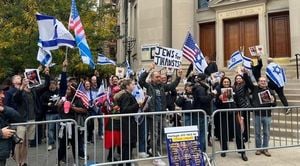It’s not every day that a quiet stretch of desert outside Las Vegas becomes the center of a mystery, but that’s exactly what happened earlier this week. On Monday, August 25, 2025, about 70 piles of cremated human remains were discovered scattered along the side of a dirt road near the rural community of Searchlight, roughly an hour’s drive south of the bustling Las Vegas Valley. The story, first reported by 8 News Now and confirmed by several outlets including The Independent and PA, has left both officials and locals searching for answers as to how and why these remains ended up in such an isolated spot.
The discovery was made by a source who stumbled upon the scene and provided photographs that quickly made the rounds among local authorities and media. The image, described as grisly and unsettling, showed what appeared to be neat mounds of ash—though, as officials clarified, these “ashes” are actually the pulverized bone fragments left after the cremation process. According to the Bureau of Land Management (BLM), which oversees much of the public land in Nevada, the remains were indeed human and had been left in approximately 70 distinct piles.
Almost immediately, the BLM launched an investigation, hoping to unravel the origins of the remains and determine whether any laws had been broken. The Las Vegas Metropolitan Police Department was also notified, though as of the time of reporting, neither agency had offered further public comment or updates beyond confirming the investigation was underway. The lack of immediate answers has only deepened the sense of unease in the small community of Searchlight and beyond.
“It’s not something you expect to see,” said one local resident, who asked to remain anonymous. “People scatter ashes out here sometimes, but never like this—never in piles like that.” The area, known for its wide-open spaces and rugged terrain, is no stranger to visitors seeking solitude or a quiet place to remember loved ones. But this particular incident, with its sheer number of remains and the apparent methodical placement, has raised eyebrows and questions in equal measure.
According to Nevada law, individuals are permitted to scatter cremated remains on public lands, a practice that’s both legal and, in many cases, deeply personal for families wishing to lay loved ones to rest in a favorite spot or beautiful setting. The law, however, draws a clear line at the commercial distribution of cremated remains, which is strictly prohibited. This means that while families can choose to scatter ashes in the Nevada desert, businesses or individuals cannot dispose of remains en masse for profit or convenience.
The BLM reiterated this distinction in statements to local media, noting, “Nevada law doesn’t prohibit a person from scattering ashes on public land, and people also aren’t prohibited from scattering cremated remains. The ‘commercial distribution of cremated remains,’ however, is not allowed.” This legal gray area has become a focal point of the investigation, as authorities work to determine whether the mass scattering was the result of individual families acting independently or a commercial operator seeking a shortcut around the law.
For now, though, the origin of the remains remains a mystery. Officials have not yet identified any funeral homes, crematoriums, or transport services connected to the incident, nor have they determined whether the remains were left intentionally or simply dumped. The possibility of an unlicensed operator, a logistical mishap, or even a coordinated act by multiple families has all been floated, but no evidence has emerged to support any one theory.
“We don’t know where the piles came from or if they were left on purpose,” an official told 8 News Now, echoing the uncertainty that’s gripped the investigation. The lack of surveillance in the remote area and the absence of identifying markers with the remains have made the task especially challenging. The BLM and local law enforcement have urged anyone with information to come forward, but as of now, the trail appears to have gone cold.
The situation has also sparked a broader conversation about the regulation of cremated remains in Nevada and across the United States. While most states allow for the scattering of ashes in certain public spaces, the rules can be complex and sometimes contradictory, leading to confusion among families and professionals alike. The sheer scale of this incident—nearly 70 separate piles—has highlighted the need for clearer guidance and, perhaps, more robust oversight.
Meanwhile, residents of Searchlight and the surrounding area are left to wonder how their quiet corner of the desert became the backdrop for such a bizarre event. Some have expressed concern about the potential environmental impact, though experts note that cremated remains are generally considered safe and inert. Others worry about the message it sends to families seeking a respectful and meaningful way to honor their loved ones.
“People come out here for peace and closure,” said another local, shaking their head. “This just feels wrong—like someone took a shortcut with something that should be sacred.” The sentiment has been echoed in online forums and community meetings, where the prevailing mood is one of discomfort and a desire for answers.
For the families whose loved ones may be among the remains, the situation is especially fraught. Without identifying information, it’s impossible to know if the ashes belonged to individuals whose families intended for them to be scattered in the desert or if they were included in the mass dumping without consent. The BLM has not indicated whether it will attempt to identify the remains, but given the nature of cremated bone fragments, the task would be daunting at best.
As the investigation continues, the story has drawn national attention, with many wondering how such a large-scale event could occur without anyone noticing. The case serves as a stark reminder of the complexities and sensitivities involved in handling human remains, especially in an era where cremation has become increasingly common.
For now, the desert near Searchlight holds its secrets, the silent mounds of ash a testament to lives lived and, perhaps, the need for greater care in their final disposition. Authorities remain on the case, but until more information comes to light, the mystery of the 70 piles of cremated remains lingers—unsettling, unresolved, and unforgettable.




